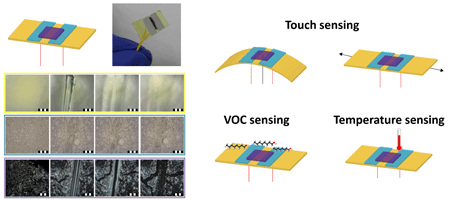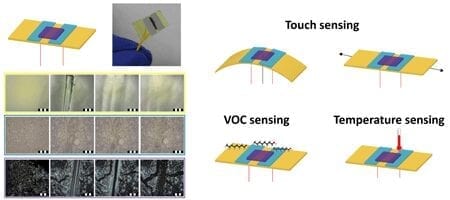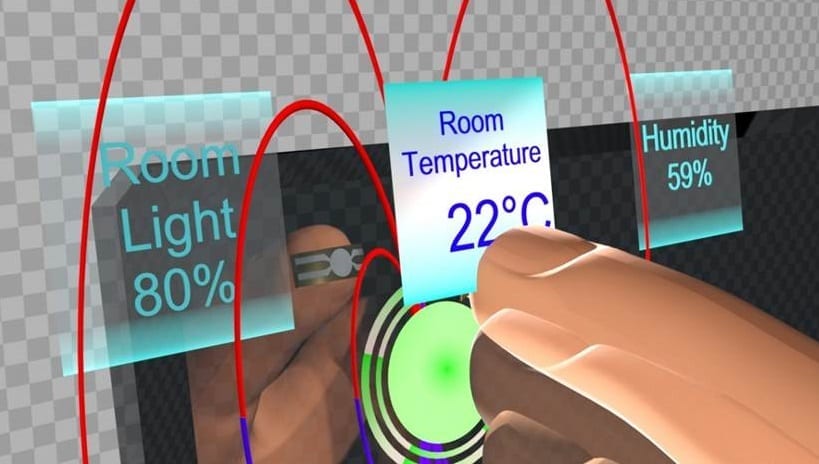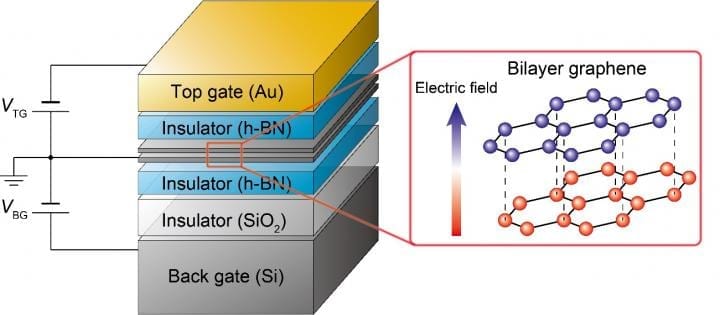
Flexible sensors have been developed for use in consumer electronics, robotics, health care, and space flight. Future possible applications could include the creation of ‘electronic skin’ and prosthetic limbs that allow wearers to ‘feel’ changes in their environments.
One problem with current flexible sensors, however, is that they can be easily scratched and otherwise damaged, potentially destroying their functionality. Researchers in the Department of Chemical Engineering at the Technion – Israel Institute of Technology in Haifa (Israel), who were inspired by the healing properties in human skin, have developed materials that can be integrated into flexible devices to “heal” incidental scratches or damaging cuts that might compromise device functionality.
The advancement, using a new kind of synthetic polymer (a polymer is a large molecule composed of many repeated smaller molecules) has self-healing properties that mimic human skin, which means that e-skin “wounds” can quickly “heal” themselves in remarkably short time – less than a day.
A paper outlining the characteristics and applications of the unique, self-healing sensor has been published in the current issue of Advanced Materials (2015) (DOI: 10.1002/adma.201504104).
“The vulnerability of flexible sensors used in real-world applications calls for the development of self-healing properties similar to how human skins heals,” said self-healing sensor co-developer Professor Hossam Haick. “Accordingly, we have developed a complete, self-healing device in the form of a bendable and stretchable chemiresistor where every part – no matter where the device is cut or scratched – is self-healing.”
The new sensor is comprised of a self-healing substrate, high conductivity electrodes, and molecularly modified gold nanoparticles. “The gold particles on top of the substrate and between the self-healing electrodes are able to “heal” cracks that could completely disconnect electrical connectivity,” said Prof. Haick.
Once healed, the polymer substrate of the self-healing sensor demonstrates sensitivity to volatile organic compounds (VOCs), with detection capability down to tens of parts per billion. It also demonstrates superior healability at the extreme temperatures of -20 degrees C to 40 degrees C. This property, said the researchers, can extend applications of the self-healing sensor to areas of the world with extreme climates. From sub-freezing cold to equatorial heat, the self-healing sensor is environment-stable.
The healing polymer works quickest, said the researchers, when the temperature is between 0 degrees C and 10 degrees C, when moisture condenses and is then absorbed by the substrate. Condensation makes the substrate swell, allowing the polymer chains to begin to flow freely and, in effect, begin “healing.” Once healed, the nonbiological, chemiresistor still has high sensitivity to touch, pressure and strain, which the researchers tested in demanding stretching and bending tests.
Another unique feature is that the electrode resistance increases after healing and can survive 20 times or more cutting/healing cycles than prior to healing. Essentially, healing makes the self-healing sensor even stronger. The researchers noted in their paper that “the healing efficiency of this chemiresistor is so high that the sensor survived several cuttings at random positions.”
The researchers are currently experimenting with carbon-based self-healing composites and self-healing transistors.
“The self-healing sensor raises expectations that flexible devices might someday be self-administered, which increases their reliability,” explained co-developer Dr. Tan-Phat Huynh, also of the Technion, whose work focuses on the development of self-healing electronic skin. “One day, the self-healing sensor could serve as a platform for biosensors that monitor human health using electronic skin.”
Read more: SELF-HEALING SENSOR BRINGS ‘ELECTRONIC SKIN’ CLOSER TO REALITY
The Latest on: Self-Healing Sensor
[google_news title=”” keyword=”Self-Healing Sensor” num_posts=”10″ blurb_length=”0″ show_thumb=”left”]
via Google News
The Latest on: Self-Healing Sensor
- Best Asus ROG Phone 8 screen protectors in 2024on May 5, 2024 at 6:00 pm
The Asus ROG Phone 8 and 8 Pro have a fantastic display that produces vibrant colors and deep blacks. It can also get pretty bright, with a peak brightness of 2500 nits. However, like any other ...
- Skin Care Newson May 3, 2024 at 5:01 pm
Discovery Has Potential to Solve the Billion-Dollar Global Cost of Poorly Managed Wound Healing Mar. 27 ... a stretchable and adhesive microneedle sensor that can be attached to the skin and ...
- AI smartphones may soon help monitor chronic wounds from homeon April 24, 2024 at 5:00 pm
The goal is to empower patients by giving them free, usable technology they can download that will provide exact measurements on how the wound is healing — and keep them ... with a low-cost ...
- CONTROLS | Bluetooth NLC offers path to interoperabilityon April 24, 2024 at 10:09 am
Full-stack standardization for lighting control devices improves the operation of lighting networks, amplifying prospects for wireless control systems adoption, writes CRAIG ...
- Best Samsung Galaxy S24 Ultra screen protectors in 2024on January 18, 2024 at 1:16 am
Each kit comes with two TPU screen protectors with self-healing capabilities for smaller ... It works flawlessly with the Galaxy S24 Ultra fingerprint sensor. It also includes a blue-light filter ...
- The aptihealth Android mobile app increases behavioral health services’ access and effectivenesson December 19, 2023 at 8:37 pm
Each sensor collects a different type of patient physiological ... Patients who feel hopeless and lost can realize a better life outlook through therapy. Healing from Stress, Trauma, and/or Exhaustion ...
- The emerging nanomedicine landscapeon September 13, 2020 at 6:20 am
Furthermore, nanostructured materials can stimulate self-healing cell responses or can ... In vitro diagnostics. Novel sensor concepts based on nanotubes, nanowires, cantilevers or atomic force ...
- Lasik eye surgeryon August 15, 2020 at 1:19 am
Problems related to healing, infection ... in which the surgeon uses a wave-front sensor to guide a computer-controlled laser, is $1,822, the Healthcare Blue Book says. And the average national ...
- Nanoparticles Types, Properties and Useson April 3, 2019 at 9:28 am
Nanoparticles exist for highly efficient hydrogen storage systems, self-healing materials, and coatings that switch their color using sensor technology. Nanoparticles are increasingly found in a wide ...
- AI equipment health monitoring and prediction technologyon December 12, 2018 at 1:41 pm
In studies with two top auto makers, sensor data was fed directly into the HMP system ... BISTel HMP Foundation for prescriptive, self-healing applications Equipment HMP takes advantage of full trace ...
via Bing News











